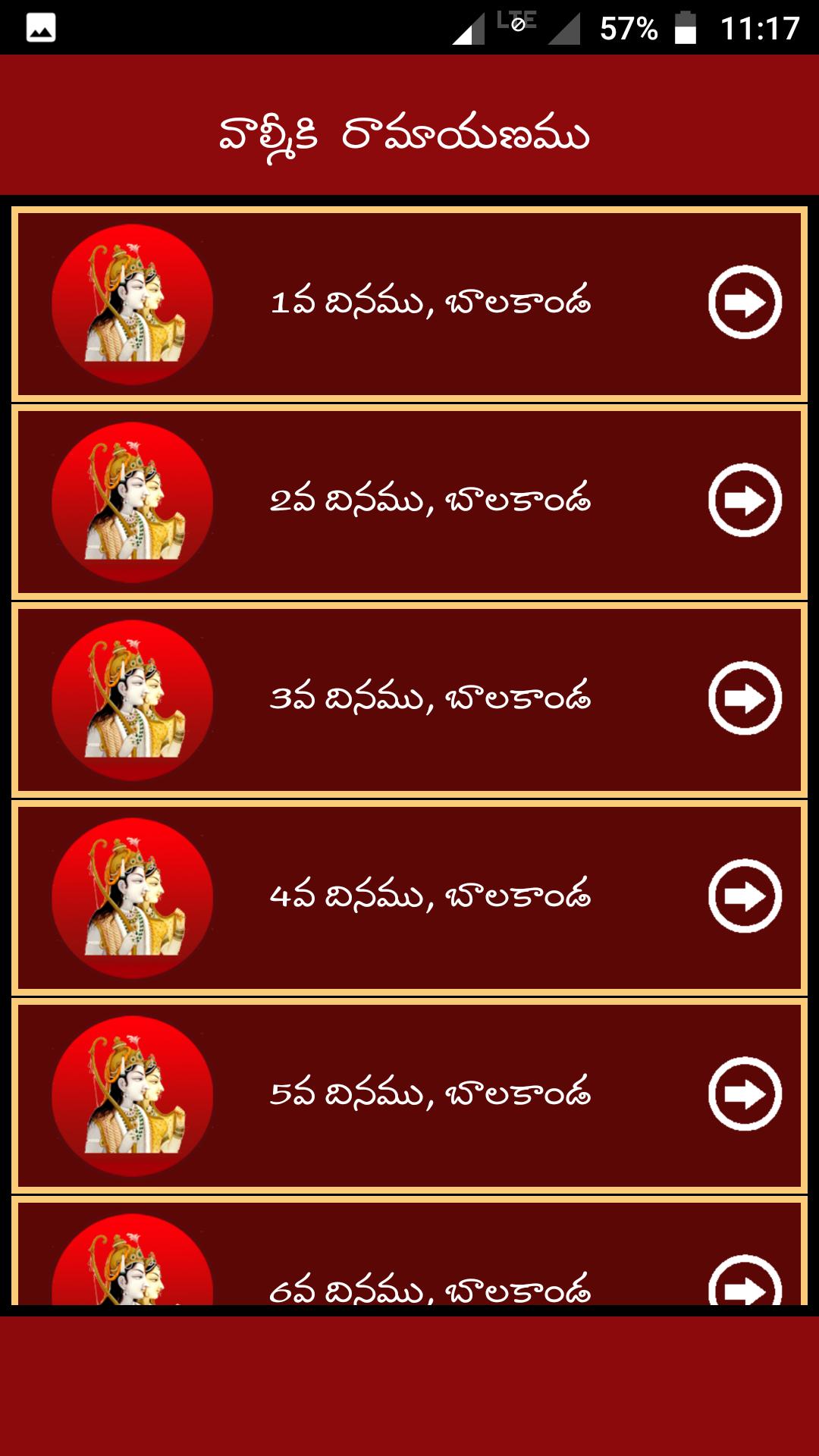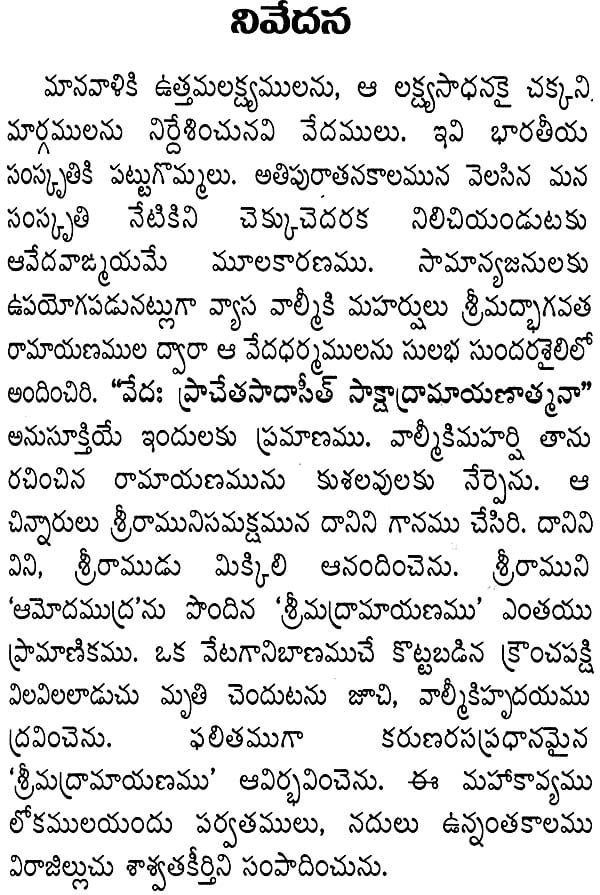Sri Ranganatha Ramayanamu[1] (శ్రీ రంగనాథ రామాయణము) is one of the most famous adaptions of the ValmikiRamayana in Telugu, a Dravidian language spoken by the people of Andhra Pradesh and Telangana. Telugu has a very rich literary tradition, starting in the 11th century A.D. Although there are more than forty adaptions of the Valmiki Ramayana which are partly or completely in Telugu, only four adaptions have covered the entire theme of the original epic. They are Ranganatha Ramayana, Bhaskar Ramayana, Molla Ramayana, and Ramayana Kalpavriksham.
Ranganatha Ramayana was written by the poet Ranganatha—also known as Gona Budda Reddy—between 1300 and 1310 A.D. This Ramayana was composed in 17,290 couplets (in Dwipada metre). This meter is lyrical and can either be recited like the Valmiki Ramayana (written in Anustupa metre) or sung like the Ramcharitmanas (written in Doha-Chaupai). It is quite popular with both scholars and illiterates.
M.V.Subrahmanyam,B.A.,B.G.L., Former Registrar AP High Court, 2-31 Chaitanyapuri Colony, Hyderabad 500060 South India Mobile Nos: /.
- శ్రీ రామాయణము ఎవమ్ హనుమన్ చాలీసా: Shri Nama Ramayana and Hanuman Chalisa (Telugu) Paperback (Edition: 2014) Gita Press, Gorakhpur.
- Valmiki Sundarakanda. Sankshipta Sundarakanda in Sanskrit. Sankshipta Sundarakanda in Telugu. Sankshipta Sundarakanda in Kannada. Sankshipta Sundarakanda in Malayalam. Sundarakanda Katha in Telugu. According to traditional folklore Ramayana text has twenty four thousand Slokas corresponding to the twenty four syllables of Gayatri.
- Telugu: Sarartha Deepikai. Pasurappadi Ramayanam (Divyaprabandha Pasura Ramayanam). Ramanuja Shabdam in Sri Ramayanam. Sanskrit: English: Sanskrit: Tamil.
It was published by Rayalu and Co, Kadapa in 1949.[2]
Structure[edit]
Although Ranganatha follows the theme of the Valmiki Ramayana, he still made changes in some incidents which effects the course of events.The theme of the Ranganatha Ramayana has been classified under seven cantos.
- Bala Kanda (Chapter: Childhood; బాల కాండ): This covers the theme starting from the conversation between Valmiki and Narada to the return of Rama to Ayodhya after his marriage with Sita from Mithila.This canto describes an incident connected with young Rama and Manthara (whereas in the Valmiki Ramayana, Manthara's entry is in Ayodhya kanda). When Rama was playing with a ball and a stick, suddenly Manthara threw the ball far away from Rama. In anger, Rama struck her on the knee with the stick and her knee was broken. This message was conveyed to king Dasaratha by Kaikeyi. The king decided to send Rama and his other sons to school. This incident makes the king to think about his responsibility of educating his sons, so that they can learn and become wise. Manthara had developed a kind of antagonism towards Rama and was waiting for an opportunity to take revenge against him.
- Ayodhya Kanda (Chapter: Ayodhya; అయోధ్యకాండ)
- Aranya Kanda (Chapter: Forest; అరణ్యకాండ)
- Kishkindha Kanda (Chapter: Kishkindha; కిష్కిందకాండ )
- Sundara Kanda (Chapter: Beautiful;సుందరకాండ )
- Yudha Kanda (Chapter: War;యుద్ధకాండ)
- Uttara Kanda (Chapter: Last;ఉత్తరకాండ)

Valmiki Ramayanam Telugu

Blessing of Squirrel[edit]

Ramayanam Story In Telugu
Ranganatha added some significant incidents to make the theme more natural and reliable. For example, when the bridge was built, a squirrel thinks that it should help Rama to achieve his end; it rolls down in the sand and gets rid of the sand on the bridge under construction. Knowing this, Rama blesses squirrel for its devotion and draws three lines on its back with his fingers. The three white lines on the back of squirrels are supposed to have come into existence in this way.
Sri Nama Ramayanam In Telugu
References[edit]
- ^Gilbert Pollet (1 January 1995). Indian Epic Values: Rāmāyaṇa and Its Impact : Proceedings of the 8th International Rāmāyaạ Conference, Leuven, 6-8 July 1991. Peeters Publishers. p. 59. ISBN978-90-6831-701-5.
- ^Gona Budda Reddy (1949). Ranganatha Ramayanamu (in Telugu). Kadapa: Rayalu and Co. Retrieved 22 June 2020.
Sri Ramayanam In Telugu News Paper

Sri Ramayanam Telugu Movie
Sri Ramayanam Telugu Serial
Om Sri Ram Valmiki Sundarakanda | |
According to traditional folklore Ramayana text has twenty four thousand Slokas corresponding to the twenty four syllables of Gayatri mantra. The first Sloka of Sundarakanda has the twelfth syllable of the twenty four syllables of the Gayatri mantra, placing Sundarakanda in a way at the virtual center or the heart of Ramayana Sundarakanda is probably the most widely read part of Ramayana and carries a widely known verse about itself saying In Sundarakanda Rama is beautiful , Sita is beautiful, Hunuman is beautiful ,. What is not beautiful in Sundarakanda? Considering the tradition of naming a book or chapter of a book after the main character, one can conclude Sundarakanda is about Sundara , the Hunuman who is the center piece of action in Sundarakanda. Sundarakanda is the story of the determination of Hanuman in achieving the task he set out as stated in the opening stanza of Sundarakanda. The story built in Sundarakanda can be briefly stated as follows. Hanuman flies across the ocean overcoming several obstacles , enters Lanka, after intensive search finds Sita , identifies himself as the messenger of Rama , takes her message and a token Chudamani from her as an identification , then announces himself as the servant and messenger of Rama, destroys the palace garden of Ravana, gains audience with Ravana, conveys his own message to Ravana saying return Sita or face annihilation . When his message of conciliation was rejected and his tail was set on fire , he uses that to burn down the city of Lanka , returns triumphantly to Kishkindha and conveys to Rama that Sita is safe but in the custody of the Rakshasa King Ravana in Lanka , continuously pining for Rama and awaiting action by Rama to get her released. Stripped of religious overtones , Sundarakanda starts in the background where in Sri Rama and Sita have gone through relentless troubles and difficulties in terms of the abrupt cancellation of coronation, banishment to the forests , the death of father Dasaratha , the abduction of Sita . Sri Rama himself says, 'Kingdom is Lost. Living in forest. Lost Sita. Now this Bird Jatayu is dead. This is all my misfortune which can even destroy fire. Starting in this background , the exploits of Hanuman in crossing the ocean create a sense of exuberance. The long sought after success in locating Sita , bringing peace to her agitated mind , bringing peace to Rama by informing him of the safety of Sita provide a turning point in Ramayana . So much so that the tradition has it that Sadhana connected with Sundarakanda creates a sense of peace and success for those who undertake the Saadhana of Sundarakanda. Over the ages Sundarakanda in Ramayan acquired an importance of its own , much like the Bhagavad-Gita in Mahabharata, which is an epic which came after Ramayana. The two central images of Sundarakanda which created an aura , which made it an entity in the daily parayana, the program of prayer in many families are the roles of Hanuman and Sita. Hanuaman is depicted as the selfless ,devoted , courageous , intelligent , powerful , but simple Rambhakt , a devotee of Rama . Sita is portrayed as the deeply afflicted and sorrowing wife, yet endowed with an unflinching wifely devotion for Sri Rama such as when she declares With such strong portrayals of unbounded loyalty and devotion , number of beliefs have sprung up in the tradition bound Indian families . It is said that when a man has some great issue at stake that will either mend or mar his life, he reads Sundarakanda or hears it expounded. When a man is ill , past medical help people believe if one reads Sundarakanda Maruti will bring him back to life and good health. This is only to illustrate the beliefs which grew over the ages about the power of Sundarakanda in the tradition bound Indian families . But there is certainly more to Sundarakanda if one were to look at the inner meaning or the buried message in Sundarakanda than the beliefs built about its mystic powers. While Sundarakanda occupies such prime place in the Indian family tradition , for some not so clear reasons it has not been adequately represented in the academic curriculum of Sanskrit Students except in terms of a chapter or two. This is possibly because of the size of Sundarakanda. There are no shortened versions of Sundarakanda solely using the slokas of Valmiki which capture the story in its entirety. Sundarakanda contains more than three thousand slokas covering wide variety of imagery , the flight of Hanuman across the sea , search for Sita in Lanka as well as the lengthy discourses between Hanuman and Sita , Hanuman and Ravana . In addition there are Hanumans own soliloquies. The present effort is a continuation of an earlier effort initiated by presenting the full thread of Sundarakanda in two hundred and ninety six slokas of Valmiki Sundarakanda in Telugu script in the form “Sankshipta Sundarakanda” , brought out by Kasarabada Kamaraju Charitable trust. This is not a critical effort and is not aimed at appreciation by critics. This could be seen as the first reading for uninitiated in the mysteries of Sundarakanda with the hope after going through this, one would go to the full Sundarakanda. Kasarabada Kamaraju Charitable Trust. | |
